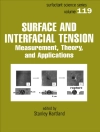Bringing together experts from the various disciplines involved, this first comprehensive overview of the current level of stress engineering on the nanoscale is unique in combining the theoretical fundamentals with simulation methods, model systems and characterization techniques.
Essential reading for researchers in microelectronics, optoelectronics, sensing, and photonics.
表中的内容
Part I
Fundamentals of stress and strain on the nanoscale
– Elastic strain relaxation: thermodynamics and kinetics
– Elasticity for nanoscale objects
– Onset of plasticity in crystalline nanomaterials
– Relaxations on the nanoscale: an atomistic view by numerical simulations
Part II
Model systems with stress-engineered properties
– Accommodation of lattice misfit in semiconductor heterostructure nanowires
– Strained Silicon Nanodevices
– Stress in heteroepitaxy as a tool to tailor magnetic nanostructures
– Self-organized Nanopatterning and Growth on Metallic Surfaces
– Semiconductor-templates for anisotropic fabrication of nano-objects
Part III
Characterisation techniques of measuring stresses on the nanoscale
– Advances and limits of transmission electron microscopy (TEM) for measuring strain at the nanoscale
– Determination of Elastic Strains using Electron Backscatter Diffraction in the Scanning Electron Microscope
– X-ray Diffraction analysis of elastic strains at the nanoscale
– Diffuse x-ray scattering at low-dimensional nanostructures
– Direct observation of elastic displacement modes by grazing-incidence X-ray diffraction
– Solar Silicon characterized by Raman Spectroscopy: From Micro- to Nanometer Scale Resolution
– Strain induced nonlinear optics in silicon
关于作者
Margrit Hanbuecken is Research Director in the French National research Council (CNRS) and director of the Competence Centre of Nanosciences and Nanotechnologies of the Provence-Alpes-Côte d’Azur region, a centre uniting 40 laboratories of the region. Her group at CINa M-CNRS in Marseille develops new strategies for the nanofabrication and functionalisation of novel templates, subsequently used in different fields going from biology to spintronics and looking at fundamental aspects as well as applications. Dr Hanbücken has authored over 70 publications, patents and book chapters.
Pierre Mueller is professor at the University Paul Cézanne and vice dean of the Science and Technology School of St Jérôme in Marseille, France. His research is dedicated to physics at the surface with a strong expertise in surface elasticity, surface thermodynamics and crystal growth mechanisms. Pierre Müller has authored more than 60 publications and has given 24 invited lectures. He regularly organizes the International Symposium on Surface Science.
Ralf Wehrspohn is Full Professor in Experimental Physics at the University of Halle-Wittenberg and Director of the Fraunhofer Institute for Mechanics of Materials which is also located in Halle, Germany. He has received the outstanding young inventor award of the German Science Foundation and is one of the TR100 nominated by the MIT Technology Review in 2003. Dr. Wehrspohn is author of more than 100 publications and co-inventor of nine patents. Since January 2006 he has been editor co-editor of Applied Physics A.












